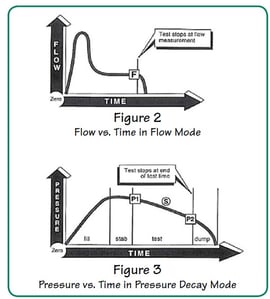Burst Testing
This Application Note describes how burst testing is accomplished using a manual regulator and a precision flow control on the Sprint iQ leak tester.
Production and test engineers often know the leak rate of product in bubbles per minute, but do not have an accurate way to convert bubbles to more universal flow numbers such as cubic centimeters per minute.
Normal leak testers use just a pressure sensor and cannot easily quantify a leak. Users must determine the volume of the products they want to test and then program those numbers into the tester (if possible) to make the tester perform the pressure-to-flow calculations. Not an easy task.
The flow model testers incorporate two precision sensors: a pressure transducer and a mass flow transducer. To quantify a leak, users simply connect a leaking product to the tester, set it to FLOW mode, and the tester measures the leak in flow units. There is no need to enter the product volume. Results are given directly in flow units that are user selectable.
Leak quantification works like this:

Flow Mode
In flow mode, Sprint iQ fills the product and takes on flow measurement [F] at the programmed test time. After Sprint iQ takes the flow measurement, the test ends. (Figure 2)
Pressure Decay Mode
In pressure decay mode, Sprint iQ cycles through fill, stabilization, test and dump phases. It is during the test phase the Sprint takes two pressure measurements: the first reading at [PT1] and the second reading at [PT2]. (Figure 3)
At the end of the test phase, Sprint iQ displays the pressure drop (P1 minus P2) in the pressure units that were selected by the user.
In pressure decay mode, the slope of the pressure curve (S) is related to the flow measurement made at (F) in flow mode.

The Sprint iQ model PF, with both pressure and mass flow sensors, is an important tool when changing over from bubble testing to electronic pressure decay testing. Often used in Research and Development, the IQ-PF is used to develop leak testing specification for a variety of products.
A broad range of products can be measured in fl ow units and then switched to pressure decay testing. The tester can also be used to detect gross leaks using mass fl ow with the advantage of reduced test time.
For more information about the mechanics of mass flow measurement, please see the separate Application Note titled “Mass Flow Theory.”
This Application Note describes how burst testing is accomplished using a manual regulator and a precision flow control on the Sprint iQ leak tester.
The Sprint iQ bidirectional check valve tester is equipped with a precision flow control and two pressure sensors.
The Sprint iQ check valve tester is equipped with a flow control and an additional transducer called a downstream sensor..
Industries
